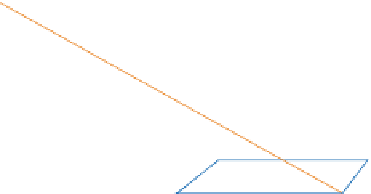Geoscience Reference
In-Depth Information
of sunspots and solar flares. The solar wind interacts with
the magnetosphere, the magnetic field that surrounds
Earth, and this interaction is visible as the
aurora
.
Let us look in more detail here at the diurnal and
seasonal effects of radiation received at the top of the
atmosphere.
between zero and twenty-four hours, depending upon the
time of year.
Seasonal variation
Seasonal variations in insolation arise from the changing
axial tilt of Earth relative to the sun throughout the year
(
Figure 2.12
)
and the eccentricity of Earth's orbit. The
orbit is an ellipse, not a circle, so that Earth is slightly
nearer the sun (147 M km) on 3 January and at its farthest
distance (152 M km) on 4 July. The variation in distance
means that the amount of energy received also varies.
The variation in energy received is ±3·5 per cent, which
does make a measurable difference in total insolation
received in the two hemispheres (
Figure 2.13
).
Being
nearer the sun means that the radiation input will be
slightly higher. Earth is closest to the sun (
perihelion
)
in the northern hemisphere winter and farthest away
(
aphelion
) in the southern hemisphere winter at the
present time. Because of changes in the shape of Earth's
orbit, to be discussed in
Chapter 9,
these relationships are
constantly changing.
As Earth orbits the sun with its axis of rotation pointing
in a constant direction, the area that is illuminated by the
sun and the angle between the sun's rays and the top of
the atmosphere will change. At the June solstice the sun
is above the horizon throughout the twenty-four hours
for all latitudes north of the Arctic Circle, while south of
the Antarctic Circle the sun would not be visible. Between
the autumn equinox (22 September) and the winter
solstice (22 December) the latitude at which the midday
sun is overhead gradually moves southward from the
equator to the Tropic of Capricorn (23·5
S). By 22
December insolation will be at a maximum at that latitude
and zero north of the Arctic Circle. Between 22 December
and 21 March the sequence is reversed, and in the period
leading up to the summer solstice the latitude of the
overhead sun moves northward from the equator to the
Tropic of Cancer, insolation increases in the northern
hemisphere, and the south pole is thrown progressively
into shadow (
Figure 2.14
).
If you stand with your back to the north pole in the
northern hemisphere, the altitude of the sun is the angle
between the horizon and the sun at noon. Navigators used
to use a sextant to measure this angle. Altitude can be
calculated with the following formula:
Diurnal variation
As Earth rotates on its axis a different portion of the top
of the atmosphere will be exposed to the incoming solar
radiation (often abbreviated to
insolation
). At dawn the
sun will be low in the sky and the amount of radiation
passing through a unit area normal to the line from the
sun will be spread over a large area (
Figure 2.11
).
As the
sun rises in the sky the surface area decreases, and so
intensity increases. If our surface is eventually at right-
angles to the solar beam it will receive the maximum
intensity of radiation - the surface area is at its smallest.
As well as the angle between the sun's rays and the top of
the atmosphere and Earth's surface, the duration of
daylight will also affect the amount of radiation received.
At the equator the day remains approximately twelve
hours long throughout the year. At the poles it varies
A
1 sq. m
Vertical rays
1 sq. m
B
a
b
Altitude = 90
- Latitude ± Declination
depends upon the angle of the incoming energy rays. Energy
distribution is more concentrated on a perpendicular surface
(A) than on a surface at a lower angle (B).
Declination is the latitude at which the sun's rays are
vertical at noon. You add declination if you are in the same
hemisphere as the sun, subtract if the sun is in the opposite














































































